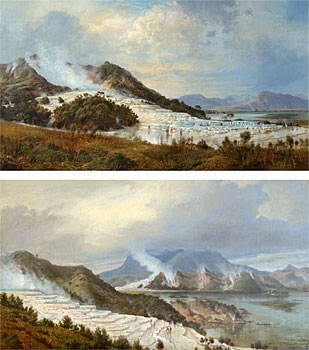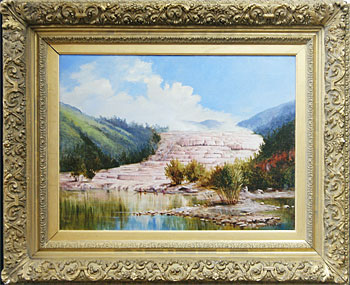Lake search finds Pink Terraces at 60 metres Thu, 03 Feb 2011

This particular story might be of interest to those many collectors who over the years have purchased a numerous works featuring the thought to be destroyed Pink & White Terraces at Rotomahana as subject matter.
NZ Herald 3 February, 2011
New Zealand's "eighth wonder of the world" has been found, 125 years after it was thought to be lost forever.
The Pink and White Terraces, New Zealand's premier tourism wonder, were buried by the gigantic eruption of Mt Tarawera in 1886.
But robot-like underwater vehicles this week found crescent-shaped terrace structures 60 metres deep in Lake Rotomahana, near Rotorua.
GNS Science project leader Cornel de Ronde said he was certain they were the bottom section of the Pink Terraces, which originally stood on the west bank of the lake.
Images taken by the vehicles showed a pinky, grime-covered staircase rising between one and two metres from the lake floor, for a length of about 70 metres.
The finding came at the end of a joint New Zealand-American project to map the lake floor and investigate the large geothermal system under the lake.
While the scientists kept an eye out for fragments of the terraces "we weren't expecting this at all," said Dr de Ronde.
"Then at the end of all the surveying ... we found something that was really hard, too hard to be anything else.
"Then bingo! We saw these terrace-like structures. I just stood there and thought, 'We've found something. Something that's meant to be gone and that nobody's seen in 125 years."'
He said the terraces - once the largest silica formations in the world - held huge cultural importance for the country, and have lived on in romanticised paintings and guidebooks.
"It must be very strong in the psyche of what a New Zealander is ... I think a lot of people would be very pleased to hear that they're still around."

The finding left the project team with some mysteries. There was no evidence of the top section of the Pink Terraces, or of the White Terraces, which were originally on the north bank.
Dr de Ronde said they could have been destroyed in the eruption, or masked from acoustic detection by thick sediment.
Anaru Rangiheuea, a kaumatua of Tuhourangi iwi, whose ancestors lived near the terraces, said his iwi were floored by the discovery.
"All you could see was my people with their mouths open and nothing coming out," he said.
"For me, it brings back a few tears and a few feelings of my people who were all buried and killed [but] I'm pleased that we are now able to say 'no, it was not all lost'."
Historian Margaret McClure said the terraces and their cascading hot pools were the spark for tourism in this country.
"Nowadays people go to Queenstown or Milford Sound. But back then it was the tourism high point. People said it was like fairyland, or Aladdin's Cave."
Visitors from Europe were taken to the tinted silica terraces in whaleboats and canoes, and bathed in the balmy waters.
The Tarawera eruption, which killed more than 100 people, left only a crater where the terraced geothermal system had been.
EIGHTH WONDER
The largest silica terraces in the world, formed on the shores of Lake Rotomahana, near Rotorua.
New Zealand's first tourist destination, and the spark for government interest in tourism, and Maori entrepreneurship in hosting visitors.
Buried and thought to be destroyed by Mt Tarawera eruption in 1886, the country's deadliest eruption.
Pink Terraces were found last week by a joint New Zealand-American project 60 metres underwater, in the 115 metre-deep lake.
Auckland's International Art Centre has sold many works of this significant and historic subject painted by 19th century New Zealand artists such as Charles Blomfield, C D Barraud, W G Baker, J B C Hoyte, T R Attwood, J P Backhouse, J D Perrett, E G Edwards, Kennett Watkins and several others.
